Three-fourth poor households without ration card didn’t receive government ration in lockdown
Seven in 10 economically weak households with no ration cards reportedly faced 'very high' or 'high' difficulty in accessing food during the lockdown.


In Rajasthan, 77% ration card holding households have received government ration. Photo: Mittal Patel
Pooja Devi, a resident of Aurangabad district in Bihar, visited her local ration shop, during the initial days of the lockdown. Of all the possessions that were left in her family of 10, she was convinced her tattered ration card would help her family access food in the ongoing coronavirus disease (COVID-19) pandemic. However, at the ration shop she was informed her card was no longer valid. This came as a blow on her face. With no jobs and barely any savings, she filled a form to apply for a new ration card, which took her three days to be filled. She is still sitting in anticipation of her new ration card.
“Just because I don’t have a ration card, does that mean that my family and I should die of starvation? We had to pay Rs 100 to get food grains for my family. There has been absolutely no help from the government,” Pooja Devi told Gaon Connection.
Twenty-two-year-old Meena Devi of Pauthu village in Aurangabad, Bihar has a similar woe. With no ration card, a dependent husband and two toddlers to take care of, her stifled income has forced her to bet the family’s survival on her father-in-law, who works as a hired labour.
Cases of Pooja and Meena echo the findings of the recent Gaon Connection national rural survey on the impact of COVID19 on rural India. It found a majority of the economically poor rural households with no ration card faced ‘very high’ or ‘high’ difficulty in accessing food during the lockdown, as they failed to receive the government ration. This national survey covered 25,300 respondents in 179 districts across 20 states and three union territories, and was conducted by Gaon Connection Insights, the data and insight arm of India’s largest rural media platform.
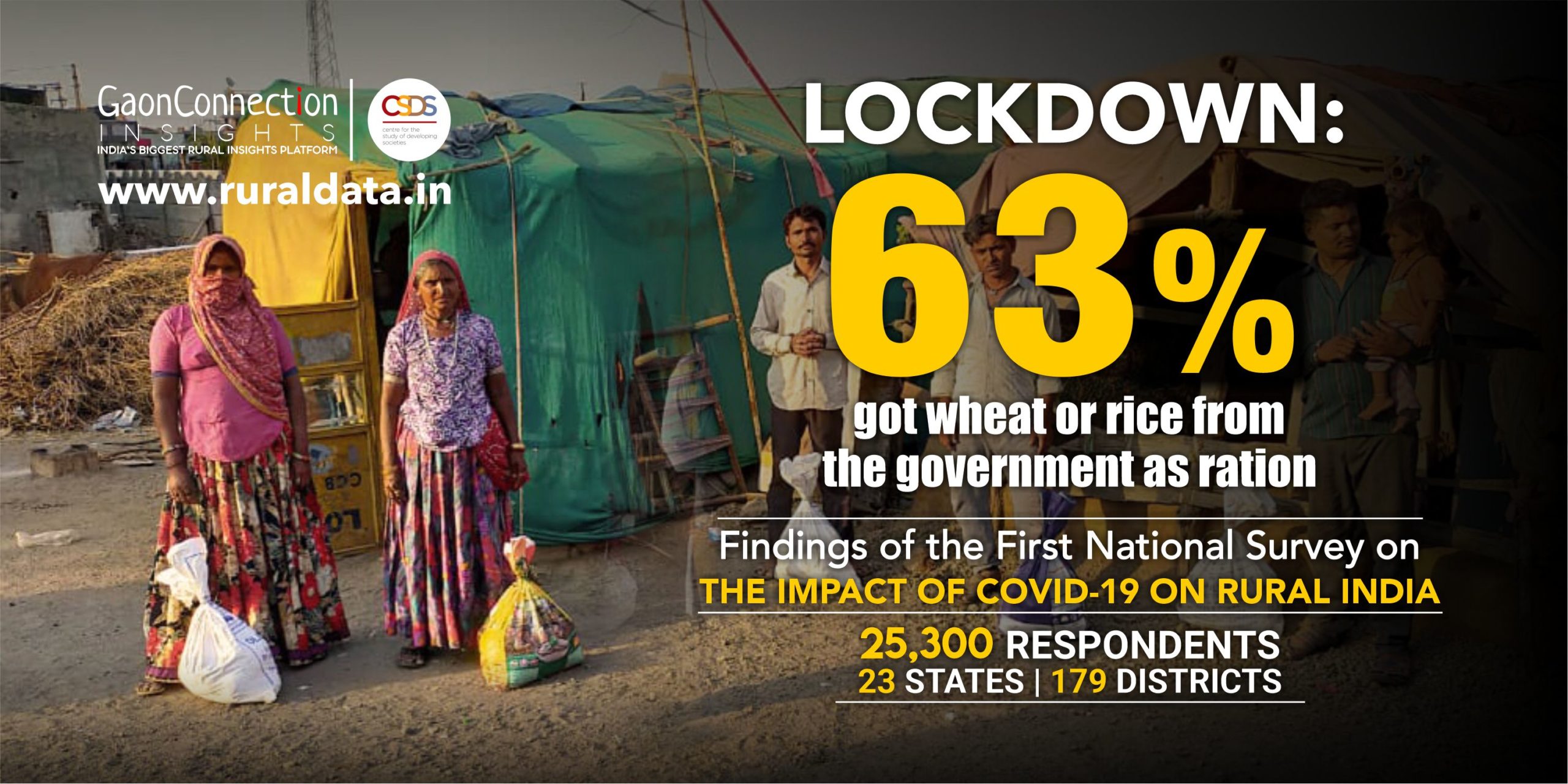
Of all the respondents interviewed as a part of the survey, overall 63 per cent households reported receiving wheat or rice from the government during the lockdown. This included 83 per cent rural households who reportedly had ration cards and 17 per cent who did not have one. In case of the economically poor households, 18 per cent reportedly did not have a ration card.

Whereas 71 per cent households with ration cards reported receiving foodgrains from the government in the lockdown, only 27 per cent households without a ration card received foodgrains support from the government in the pandemic. In the case of poor households, seven out of ten such families did not receive government ration in the lockdown.
At 87 per cent, Maharashtra topped the list of ration card holding households to have received government ration, followed by Chhattisgarh (86 per cent), J&K-Ladakh (82 per cent), Rajasthan (77 per cent), Kerala (76 per cent) and Jharkhand (76 per cent). Punjab fared very low on this parameter with only one-fourth ration card holding families reportedly receiving foodgrains from the government. This was followed by Himachal Pradesh (49 per cent).
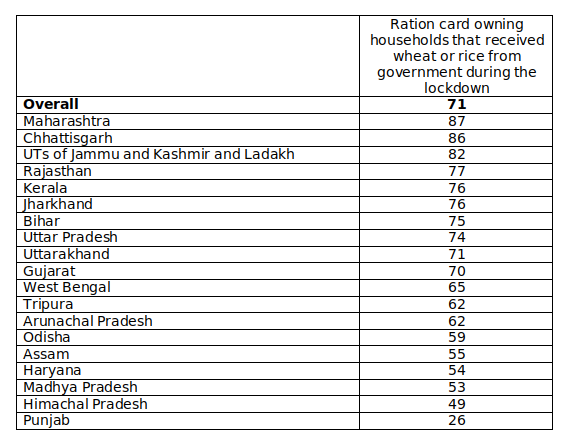
Foodgrain schemes
The Indian government has several food distribution schemes including Targeted Public Distribution Scheme (PDS) that focuses on providing subsidised foodgrains to poor families through fair price shops (ration shops). Seven years back, the National Food Securities Act, 2013 was enacted to ensure provision of highly subsidised food grains to 67 per cent of India’s 1.2 billion population.
Under the 2013 Act, foodgrain is allocated 5 kilogrammes (kg) per person per month for priority households category and 35 kg per family per month for Antyodaya Anna Yojana families at a highly subsidised prices of Re 1/-, Rs 2/- and Rs 3/- per kg for nutri-cereals, wheat and rice, respectively.
According to Dipa Sinha, assistant professor at the School of Liberal Studies, Ambedkar University, New Delhi, these provisions are not sufficient to take care of the hunger and high malnutrition in the country. Also, the population calculation for the 2013 Act was based on Census 2011. In the last one decade, the population has increased greatly but, still not all beneficiaries are covered.
After the lockdown was enforced on March 25, the Central government announced a Rs 200,000 crore economic relief package to cushion the population from the impact of the lockdown. Revered to be the most beneficial among them was the Pradhan Mantri Garib Kalyan Ann Yojana which ensured free distribution, through PDS, of 5 kg of extra rice or wheat and one kg of extra pulses to poor beneficiary households for three months. The scheme has now been extended till November this year.
In addition to this, the Central government had also announced free foodgrains supply to all migrant workers over the course of the next two months starting May. Targeted to benefit non-card holders, 5 kg wheat/rice per person and 1 kg chana per family/month was to be distributed that was expected to benefit over 80 million migrant workers. However, the government’s own data suggests that only 21.3 million workers have benefited out of the eight crore that the Atma Nirbhar package aimed to cover.
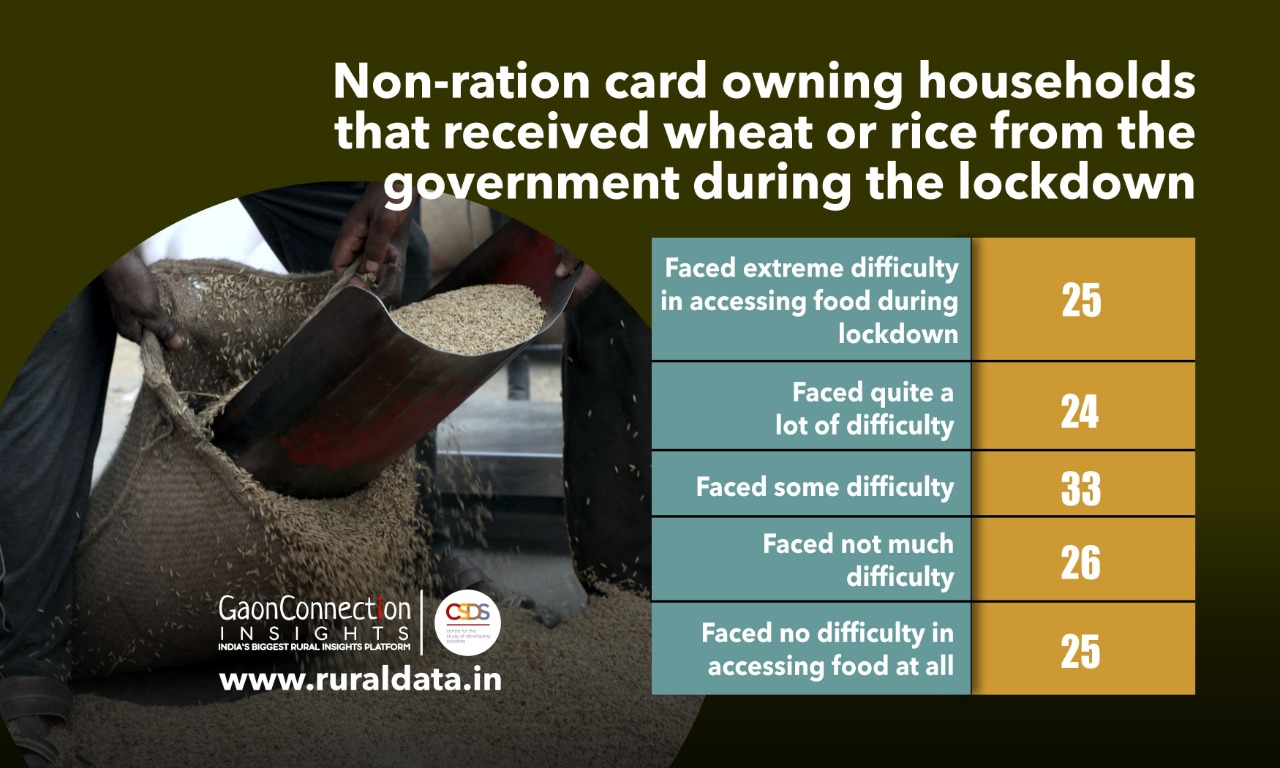
Need for universalisation of PDS
Clinical nutritionist and retired deputy director of National Institute of Nutrition, Hyderabad, Veena Shatrugna expressed grave concerns about the 17 per cent left out of the food security net. “The government only met one third of the nutritional requirement by supplying five kgs of grains because it provided only 600 calories, which is a fraction of the average requirement of 2,000 calories per person, per day,” she told Gaon Connection.
“If we really had a caring government, no person would have gone hungry. This is a time when truck loads of food should be taken to villages and irrespective of family size and ration card, people should have been provided 30 kilos of grains. Now the granaries are overflowing and will get rotten because of rains,” she added.
Right to Food activists and sector experts have been demanding universalisation of PDS in the country. “Instead of short-term schemes and one time ration distribution, the government should universalize PDS so that whoever is in need can avail of its benefits,” said Sinha. “There can be exclusions, like income tax-payers, to ensure it’s not misappropriated. But, the need and urgency of universalisation of PDS is now fulcrum to address the issue of hunger. There’s so much grain lying in the stocks so it’s not that we cannot implement this. If basic food needs are taken care of then a poor person can invest in better quality food,” she added.
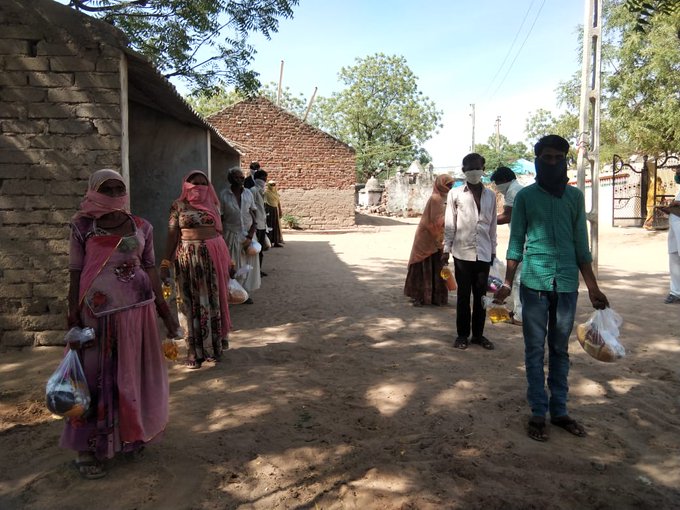
The One Nation One Ration Card (ONORC) entails integration of the existing PDS with that of the Centre thus creating a central repository of all the ration cards under the National Food Securities Act, 2013 and its beneficiaries. Under the ONORC, the government has claimed that beneficiaries could buy foodgrains from ration shops located in any of the states. However, these Aadhaar linked ration cards, according to Sinha, will only benefit those who already had a ration card and not those who did not possess one.
Sameet Panda, a lead member of Right to Food Campaign in Odisha, offered another solution — digitised ration cards akin to what has been rolled out in Tamil Nadu. “Digitised ration cards seem to be the most plausible solution to the current problem,” he told Gaon Connection. “Instead of relying on biometrics [finger prints], which tend to change, Tamil Nadu government has come up with a smart card that carries all the details of the beneficiary such as name of ration card holder, head of the household, address, etc. It’s way better than Aadhaar linking which, in my belief, causes more harm than good,” he said
Research in the recent past has shown that Tamil Nadu, running on the lines of universal PDS mode, had one of the lowest leakages in PDS as compared to states like Uttar Pradesh and Bihar that had a limited PDS outreach. Even during the 21-day national lockdown, its efficient PDS and well-stocked social welfare schemes had been hailed as a boon to many residents.
Financial schemes
The findings of the recent Gaon Connection Survey revealed that nearly two-third rural households reported receiving money from the government under some scheme in their bank accounts during the lockdown. Households in Rajasthan, Chhattisgarh, Assam, Bihar, Maharashtra and Uttarakhand seem to have benefitted the most from such financial support, whereas Jammu & Kashmir-Ladakh, Arunachal Pradesh, Gujarat benefited the least.
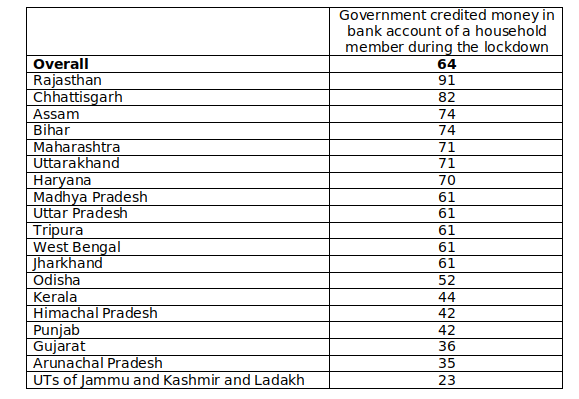
Of the total beneficiary farmers interviewed as part of the recent survey, 59 per cent beneficiary farmers said they received the due installments under the PM-Kisan Samman Nidhi (PM-KISAN), whereas over 27 per cent reportedly did not receive the promised amount.
Similarly, half the respondent households said women in their families benefited from Rs 500 per Jan Dhan account announced by the Centre during the lockdown. Thirty two per cent did not receive this money, whereas 14 per cent said they did not have the Jan Dhan account.
“The schemes run directly by the central government like PM-KISAN, Jan Dhan, Ujjwala are a bigger failure than the state government schemes,” said Panda. He claimed the benefits of Jan Dhan accounts were not reaching the poorest of the poor households, rather its beneficiaries comprised lower and middle-class villagers. “The ones who are in dire need either don’t have accounts or have been mired in some sort of a complication because of which they’re unable to access their accounts. In Odisha, the state government’s infrastructure and its schemes, such as Madhu Babu Pension Yojana and Mamata, work better than those of the central government’s and its benefits reach the ones who actually need it,” he added.

Ramandeep Singh Mann, a farmer activist based in Punjab, said during the lockdown many farmers had complained about not receiving the quarterly installment of the PM-Kisan scheme on time. The scheme offers an income support of Rs 6,000 per annum in equal installments to all farmers. Rolled out in 2018, it was initially intended for small and marginal farmer families having combined land ownership of upto two hectares but was extended to cover all farmers under its ambit.
“For people who didn’t receive installments on time, the only solution was to check with the local administration to know the reason behind the delay. However, since we were in a lockdown and nobody could venture out, all they did was wait. When the payment finally came, it was highly scattered,” Mann told Gaon Connection.
Sandeep Singhroha, a farmer hailing from Karnal, Haryana, who is a beneficiary of this scheme, questioned the frivolity of the amount disbursed under it. “If we do the maths, Rs 2,000 every four months means Rs 500 per month and Rs 17 per day. How can anyone survive on such a meagre amount in these times?” he asked. Questioning the concept of providing free food and cash transfers to farmers, he said, “Why doesn’t the government understand that farmers, as of today, wish to sell their produce at minimum support price. That’s all we want, we don’t need more subsidies.”

